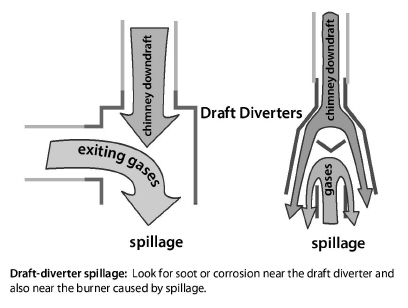
|
SWS Detail: 2.0105.1 Combustion Worker Safety, 5.3003.14 Combustion Analysis of Gas-Fired Appliances (LP and Natural Gas), 5.3003.2 Combustion Analysis of Oil-Fired Appliances |
At a minimum, evaluate the combustion safety at the weatherization job’s completion.
Make the following observations before testing to help you determine the likelihood of carbon monoxide (CO) and spillage problems.
ü Recognize soot near the draft diverter, barometric damper, or burner of a combustion appliance as a sign that the appliance has produced CO and spilled combustion gases.
ü Recognize that rust in a chimney or vent connector may also indicate spillage.
ü Look for irregularities and flaws in the venting system.
ü Specify that workers seal all accessible return-duct leaks attached to combustion furnaces.
ü Verify that the home has a working CO alarm. If the home has no working smoke alarm in addition to no CO alarm, install a combination CO-smoke alarm, or separate CO and smoke alarms.

Natural gas and propane piping systems may leak at their joints and fittings. Find gas leaks with an electronic combustible-gas detector, also called a gas sniffer. A gas sniffer finds significant gas leaks if used correctly. Remember that natural gas rises from a leak and propane falls, so position the sensor accordingly.
ü Sniff all valves and joints with the gas sniffer.
ü Accurately locate leaks using a noncorrosive bubbling liquid, designed for finding gas leaks.
ü Replace kinked or corroded flexible gas connectors.
ü Replace flexible gas lines manufactured before 1973. The line’s manufacture date is stamped on a date ring attached to the flexible gas line. If a date ring isn’t present, and you believe the gas line predates 1973, then replace the flexible gas line.

|
SWS Detail: 2.0105.1 Combustion Worker Safety, 2.0301.2 Carbon Monoxide Alarm or Monitor |
CO testing is essential for evaluating the safety of combustion and venting. Measure CO in the vent of every combustion appliance you inspect and service. Measure CO in ambient air in both the home and CAZ as part of inspection and testing of combustion appliances.
Testing for CO in the appliance vent is a part of combustion testing that happens under worst-case conditions. The DOE and BPI have two separate CO limits depending on the type of appliance. If the following CO limits are exceeded in the undiluted combustion byproducts, the appliance fails the CO test under current DOE and BPI standards.
• Space heaters and water heaters: 100 ppm as measured or 200 ppm air-free
• Furnaces or boilers: 200 ppm as measured or 400 ppm air-free
The DOE SWS require contractors to monitor CO during combustion testing to ensure that CO in the combustion appliance zone (CAZ) doesn’t exceed 35 ppm as measured. If ambient CO levels in the combustion zone exceed 35 ppm, stop testing for your own safety. Ventilate the CAZ thoroughly before resuming combustion testing. Investigate indoor CO levels of greater than 9 ppm to find their cause. See "Causes of Carbon Monoxide (CO)" on page 24.
|
SWS Detail: 2.0105.1 Combustion Worker Safety, 2.0201.1 Combustion Appliance Zone (CAZ) Testing, 2.0201.2 Combustion Safety |
CAZ depressurization is the leading cause of backdrafting and flame roll-out in furnaces and water heaters that vent into naturally drafting chimneys.
Worst-case vent testing uses the home’s exhaust fans, air handler, and chimneys to create worst-case depressurization in the combustion-appliance zone (CAZ). The CAZ is an area containing one or more combustion appliances. During this worst-case testing, you can measure the CAZ pressure difference with reference (WRT) to outdoors and test for spillage.
Worst-case conditions do occur, and venting systems must exhaust combustion byproducts even under these extreme conditions. Worst-case vent testing exposes whether or not the venting system exhausts the combustion gases when the combustion-zone pressure is as negative as you can make it. A digital manometer is the best tool for accurate and reliable readings of both combustion-zone depressurization and chimney draft.
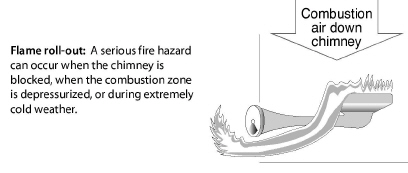
Take all necessary steps to reduce CAZ depressurization and minimize combustion spillage, based on your tests.
|
SWS Detail: 2.0201.1 Combustion Appliance Zone (CAZ) Testing, 2.0299.1 Combustion Appliance Depressurization Limits Table |
Follow the steps below to find the worst-case depressurization level in the combustion appliance zone (CAZ).
1. Close all exterior doors, windows, and fireplace damper(s). Open all interior doors, including closet doors.
2. Remove furnace filter, or replace with a new filter. Be sure the filter slot is covered.
3. Record the base pressure of the CAZ with reference to outdoors.
4. Turn on all clothes dryers and exhaust fans. (Clean clothes dryer filter trap)
5. Open or close interior doors including the CAZ door, to maximize the negative pressure. Record this pressure.
6. Turn on the furnace air handler.
7. Open or close interior doors including the CAZ door, to maximize the negative pressure. Record this pressure.
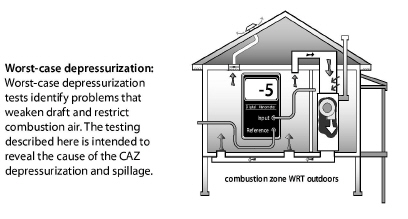
8. Calculate the net difference between the worst depressurization found from #5 or #7 and the baseline pressure. This is the worst-case depressurization.
9. Refer to the SWS 2.0299.1 Combustion Appliance Depressurization Limits Table or “SWS Maximum CAZ Depressurization” on page 483.
10. Specify improvement if the measured worst-case depressurization limit is exceeded. See "Mitigating CAZ Depressurization and Spillage" on page 242.
Troubleshooting depressurization sources: When depressurization resists simple diagnosis or persists after mitigation attempts, you can test depressurization caused by exhaust appliances and the air handler separately to determine which is the larger depressurizer. Observe the effect of opening and closing interior doors and the CAZ door to determine which house zones are causing depressurization in the CAZ.
Next, verify that the appliance venting systems don’t spill or produce excessive CO at worst-case depressurization. Test each appliance in turn for spillage and CO as described below.
1. Detect spillage at the draft diverter of each combustion appliance in one of these ways.
a. Smoke from a smoke generator being repelled by spillage at the draft diverter.
b. A mirror fogging at the draft diverter
2. If spillage in one or more appliances continues at worst-case depressurization for 2 minutes or more, take action to correct the problem.
3. Measure CO in the undiluted flue gases of each space heater or water heater after 5 minutes of operation at worst-case depressurization. If CO in undiluted flue gases is more than 100 ppm as measured or 200 ppm air-free measurement, take action to reduce CO level.
4. Measure CO in the undiluted flue gases of each furnace or boiler after 5 minutes of operation at worst-case depressurization. If CO in undiluted flue gases is more than 200 ppm as measured or 400 ppm air-free measurement, take action to reduce CO level.
Spillage and draft: Spillage and draft are two indications of whether the combustion gases are exiting the building as they should. In this guide, we focus on spillage because it’s spillage we’re trying to avoid, and we can detect it easily.
Draft, if you measure it, should be between 0 pascals (0.000 IWC) and –10 pascals (–0.040 IWC) for atmospheric burners. Positive draft indicates spillage, but not reliably. Draft is complicated and requires training to understand what it is. Look for spillage, unless you understand draft and know how to measure it.
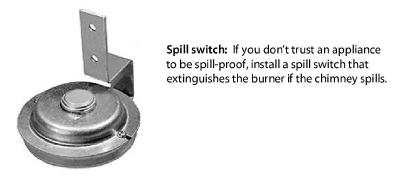
If you find problems with CAZ depressurization or spillage, consider the improvements discussed next to solve the problems.
If the appliance spills or shows inadequate draft, open a window, exterior door, or interior door to observe whether the additional combustion airflow through that opening stops the spillage.
1. If this additional air improves draft, the problem is usually depressurization.
2. If this additional air doesn’t stops the spillage, inspect the chimney. The chimney may be obstructed, undersized, oversized, or leaky.
This list of duct improvements may solve spillage problems detected during the previous tests on a forced air heating system.
• Seal all return-duct leaks near the furnace.
• Isolate the CAZ from return registers and exhaust fans by air-sealing the CAZ from the depressurizing zones and providing combustion air to the sealed CAZ.
• Reduce depressurization from the exhaust appliances.
These two suggestions may reduce depressurization caused by the home’s exhaust appliances.
1. Isolate combustion appliances from exhaust fans and clothes dryers by air sealing between the CAZ and zones containing these exhaust devices as described on page 244.
2. Provide make-up air for dryers and exhaust fans and/or provide combustion air inlet(s) to the CAZ. See page 294.
|
Problem |
Possible Solutions |
|---|---|
|
Spills immediately and continuously |
Remove chimney blockage, seal chimney air leaks, or provide additional combustion air as necessary. |
|
Exhaust fans cause spillage |
Provide make-up or combustion air if opening a door or window to outdoors improves draft during testing. |
|
Blower activation causes spillage |
Seal leaks in the furnace and in nearby return ducts. Isolate the furnace from nearby return registers. |
Suggest the following chimney improvements to mitigate spillage problems detected during the previous testing.
• Remove chimney obstructions.
• Repair disconnections or leaks at joints and where the vent connector joins a masonry chimney.
• Measure the size of the vent connector and chimney and compare to vent-sizing information listed in Chapter 13 of the National Fuel Gas Code (NFPA 54). A vent connector or chimney liner that is either too large or too small can reduce draft.
• If wind interferes with draft, install a wind-dampening chimney cap.
• If the masonry chimney is corroded, install a new chimney liner.
• Increase the pitch of horizontal sections of vent.
An isolated CAZ improves the safety of atmospherically vented appliances. The CAZ is isolated if it receives combustion air only from outdoors. An isolated CAZ doesn’t require worst-case depressurization and spillage tests. However you should inspect the CAZ for connections with the home’s main zone and make sure it is isolated.
1. Look for connections between the isolated CAZ and the home. Examples include joist spaces, transfer grills, leaky doors, and holes for ducts or pipes.
2. Measure a base pressure from the CAZ to outdoors.
3. Perform 50-pascal blower door depressurization test with the combustion appliances disabled. The CAZ-to-outdoors pressure should not change more than 5 pascals during the blower door test.
4. If the CAZ-to-outdoors pressure changed more than 5 pascals, air-seal the zone, and retest as described in steps 2 and 3.
5. If you can’t air-seal the CAZ adequately to isolate the zone, solve worst-case depressurization and spillage problems as described in “Mitigating CAZ Depressurization and Spillage” on page 242.
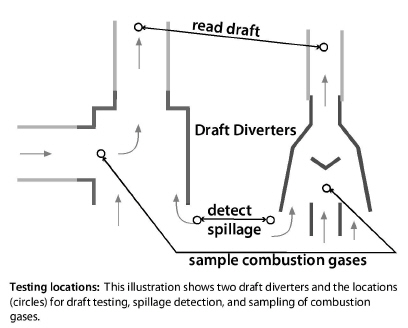
Lesson: Appliances and Naturally Drafting Chimneys
In this lesson you’ll learn about the safety issue of backdrafting, the difference between overfire draft and chimney draft, and the types of appliances that use naturally drafting chimneys. Click here to watch the video.